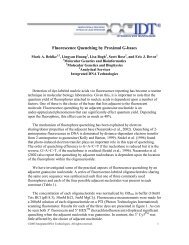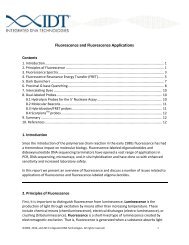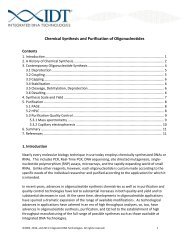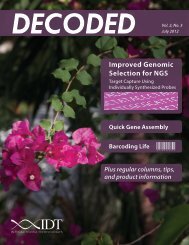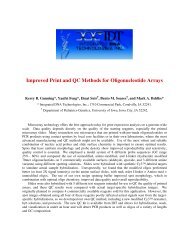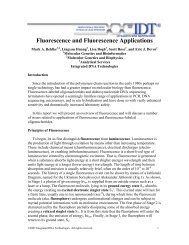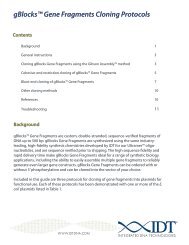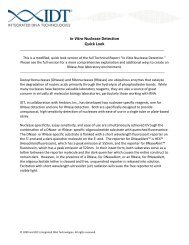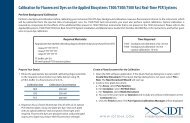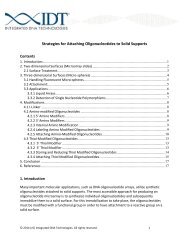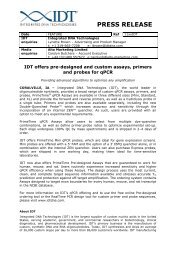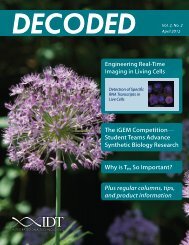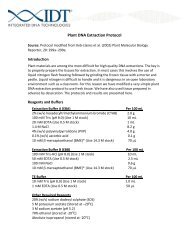xGen® Target Capture Protocol - Integrated DNA Technologies
xGen® Target Capture Protocol - Integrated DNA Technologies
xGen® Target Capture Protocol - Integrated DNA Technologies
Create successful ePaper yourself
Turn your PDF publications into a flip-book with our unique Google optimized e-Paper software.
xGen® <strong>Target</strong> <strong>Capture</strong> <strong>Protocol</strong><br />
<strong>Protocol</strong> for <strong>DNA</strong> Probe Hybridization and <strong>Target</strong> <strong>Capture</strong> Using an Illumina Library<br />
Version 1.1 (optimized for 500–600 bp fragments for 500-cycle runs on the MiSeq® System)<br />
xGen® Lockdown® Probes (biotinylated <strong>DNA</strong> capture probes)<br />
xGen® Blocking Oligos<br />
Nuclease-free Water<br />
Products Available from IDT<br />
Custom <strong>DNA</strong> Primers<br />
Illumina P5 Primer: AATGATACGGCGACCACCGA<br />
Illumina P7 Primer: CAAGCAGAAGACGGCATACGA<br />
Additional Materials Required<br />
Agencourt® AMPure® XP - PCR Purification beads<br />
Beckman-Coulter, cat. no. A63880<br />
Bioanalyzer Chips Such as Bio-Rad <strong>DNA</strong> 1K analysis chips, cat. no. 700-7107<br />
Denhardt’s Solution<br />
General lab supplier<br />
Dynabeads M-270 Streptavidin Life <strong>Technologies</strong>, cat. no. 65305<br />
EDTA<br />
General lab supplier<br />
95% or 100% Ethanol General lab supplier<br />
Human Cot-1 <strong>DNA</strong> Life <strong>Technologies</strong>, cat. no. 15279-011<br />
KAPA HiFi HotStart ReadyMix<br />
Kapa Biosystems, cat. no. KK2601<br />
Library Quantification Kit - Illumina/Universal<br />
Kapa Biosystems, cat. no. KK4824<br />
MAXYmum Recovery® Microtube, 1.7 mL VWR, cat. no. 22234-046<br />
MAXYmum Recovery® PCR Tubes, 0.2 mL flat cap VWR, cat. no. 22234-056<br />
PhiX Control v3<br />
Illumina, cat. no. FC-110-3001<br />
Qubit® Assay Tubes<br />
Life <strong>Technologies</strong>, cat. no. Q32856<br />
Qubit® ds<strong>DNA</strong> HS Assay Kit<br />
Life <strong>Technologies</strong>, cat. no. Q32851<br />
Sodium Chloride<br />
General lab supplier<br />
10X SSC<br />
General lab supplier<br />
SDS<br />
General lab supplier<br />
1M Sodium Hydroxide<br />
General lab supplier<br />
1M Tris-HCl, pH 8.8<br />
General lab supplier<br />
Tween-20<br />
General lab supplier<br />
A. Hybridization of <strong>DNA</strong> <strong>Capture</strong> Probes to the Genomic <strong>DNA</strong> Library<br />
This procedure summarizes the steps necessary for hybridization of <strong>DNA</strong> probes with an Illumina<br />
library prepared from genomic <strong>DNA</strong>. Minor modifications will be necessary to the PCR enrichment<br />
step if using an alternative platform.<br />
Before you start<br />
i. Hydrate the dried down xGen Lockdown Probes pool to 3 pmol/µL in IDTE pH 8.0. If a capture<br />
probe pool at a lower concentration is used, IDT recommends drying down a portion<br />
of the material and rehydrating in nuclease-free water to 3 pmol/µL.<br />
ii. Hydrate the Blocking Oligos to 1 mM in IDTE pH 8.0.<br />
iii. Important: Prepare all of the required buffers as indicated on page 3. Before each use,<br />
closely inspect the 2X Hybridization Buffer for precipitates. If there is a precipitate, heat to<br />
55°C for 10 min while assembling the other components.<br />
1. Hybridize xGen Lockdown Probes (or other capture probes) to target.<br />
a. Combine the following in a low-bind 0.2 mL PCR tube:<br />
3 pmol pooled xGen Lockdown Probes (1.5 pmol/µL) 2.0 µL<br />
500 ng Illumina library (dried down, and then resuspended in water to 125 ng/µL) 4.0 µL<br />
2 µg Cot-1 <strong>DNA</strong> (1 µg/µL) 2.0 µL<br />
1 mM Blocking Oligo 1 1.0 µL<br />
1 mM Blocking Oligo 2 1.0 µL<br />
Total Volume 10 µL<br />
b. Add 10 µL 2X Hybridization Buffer and vortex.<br />
c. Overlay with 40 µL mineral oil. DO NOT vortex after overlaying with oil.<br />
IMPORTANT: It is essential that you overlay with mineral oil to avoid significant<br />
volume loss.<br />
d. Denature the mixture in a thermal cycler at 95°C for 5 min, and then slowly decrease<br />
the temperature (0.1°C/sec) to 71°C. DO NOT use the heated lid of the thermal<br />
cycler.<br />
e. Incubate at 71°C for 48 hr. This reaction will be used in Step 2.e. (below).<br />
2. Bind hybridized target to streptavidin beads.<br />
a. Allow Dynabeads® M-270 Streptavidin (Invitrogen) to equilibrate to room temperature<br />
for 30 min.<br />
b. Pipet 50 µL M-270 streptavidin beads into a fresh 1.7 mL low-bind microcentrifuge<br />
tube and wash twice with 50 µL 2X Bind and Wash Buffer. Use a pipette to remove<br />
the buffer after each wash.<br />
c. Combine the following to make Bead Resuspension Buffer:<br />
2X Bind and Wash Buffer 50 µL<br />
Nuclease-Free Water 30 µL<br />
Total Volume 80 µL
xGen® <strong>Target</strong> <strong>Capture</strong> <strong>Protocol</strong><br />
d. Resuspend the washed beads in 80 µL Bead Resuspension Buffer (from 2.c.).<br />
e. Recover the hybridization reaction (20 µL) from under the mineral oil (step 1.e.; above),<br />
being careful not to withdraw any mineral oil, and add to the resuspended beads.<br />
Hint: A gel-loading pipette tip makes it easy to remove the liquid from under the mineral<br />
oil. To avoid trapping any mineral oil in the tip, leave a small amount of positive pressure<br />
in the tip until reaching the mineral oil/hybridization solution interface. Expel the small<br />
amount of oil in the tip before removing the hybridization mixture.<br />
f. Place the tube on tube rotator/nutator mixer for 30 min to bind the biotinylated<br />
capture probes to the streptavidin beads.<br />
3. Wash the streptavidin beads to remove unbound <strong>DNA</strong>.<br />
a. Briefly spin down the tube from step 2.f. (above) and place on a magnetic separation<br />
rack. Allow beads to separate from the supernatant. Using a pipette, remove the<br />
supernatant containing unbound <strong>DNA</strong> and discard.<br />
b. Wash the beads with the following solutions, sequentially:<br />
i. 1000 µL Wash Buffer 1 for 5 min, 71°C with rotation<br />
ii. 1000 µL Wash Buffer 2 for 5 min, 71°C with rotation<br />
iii. 1000 µL Wash Buffer 2 for 5 min, 71°C with rotation<br />
iv. 1000 µL Wash Buffer 2 for 5 min, RT with rotation<br />
v. 1000 µL Wash Buffer 3 for 30 sec, RT with tube on magnet; keep tube on magnet<br />
• Ensure that each solution has been pre-equilibrated to the appropriate wash<br />
temperature.<br />
• Add the stated volume of each wash buffer to the tube and place on a bench<br />
top tube rotator/nutator mixer for the indicated amount of time.<br />
• Pulse spin (1–3 sec, 800 x g) to collect the liquid without pelleting the beads.<br />
• Place tube on magnetic holder to attract the magnetic beads.<br />
• Remove wash buffer using a pipette.<br />
IMPORTANT! After the final wash (v), do not remove tube from magnet!<br />
Remove ALL of the Wash Buffer 3 from the tube after the final wash. SSC present in the<br />
buffer may react with NaOH used in subsequent steps to produce a precipitate that will<br />
interfere with downstream manipulations.<br />
c. Add 50 µL 125 mM NaOH (freshly diluted from a more concentrated stock solution)<br />
and incubate at RT for 10 min. Vortex every 2 min to keep beads in suspension.<br />
d. Return the tube to the magnet for 1 min. Leave the tube on the magnet while you<br />
perform the next steps.<br />
e. Add 50 µL 1 M Tris-HCl, pH 8.8, to a new 1.7 mL low-bind tube.<br />
f. Keeping the tube on the magnet, transfer the supernatant (d) to the tube of<br />
1 M Tris-HCl (e). This neutralizes the NaOH added to the hybridization mixture.<br />
g. Add 1.5X volumes (150 µL) Agencourt® AMPure® XP beads (Beckman-Coulter). Proceed<br />
according to the manufacturer’s protocol, eluting in 22 µL Elution Buffer.<br />
h. Transfer 20 µL of eluted product into a new 1.7 mL low-bind tube, ensuring no beads<br />
are carried over.<br />
B. Post-<strong>Capture</strong> PCR<br />
The eluate from step A.3.h. above allows retention of a small amount of captured library for troubleshooting,<br />
if necessary. Otherwise, the library can be eluted in a smaller volume and the entire amount<br />
used in the final PCR enrichment.<br />
1. Perform final PCR enrichment.<br />
a. Prepare the following reaction mix in a low-bind 0.2 mL PCR tube:<br />
2X KAPA HiFi HotStart ReadyMix 25 µL<br />
10 µM Illumina P5 Primer 2.5 µL<br />
10 µM Illumina P7 Primer 2.5 µL<br />
Nuclease-Free Water 4 µL<br />
Eluted capture library 16 µL<br />
Total Volume 50 µL<br />
b. Briefly vortex the tube, and then spin briefly in a microcentrifuge to collect the reaction<br />
mixture at the bottom of the tube.<br />
c. Place reactions in a thermal cycler and run the following program:<br />
98°C 5 min<br />
98°C 20 sec<br />
}<br />
60°C 15 sec 14<br />
72°C 20 sec<br />
72°C 5 min<br />
4°C Hold<br />
cycles<br />
xGen® <strong>Target</strong> <strong>Capture</strong> <strong>Protocol</strong><br />
Note: Fewer cycles may be performed depending on the yield of the captured library. We<br />
recommend starting at 14 cycles to ensure enough material for loading on the sequencer<br />
without over-amplifying and biasing the library.<br />
d. Purify the fragments using 1.5X volume (75 µL) Agencourt AMPure XP beads. Proceed<br />
according to the manufacturer’s protocol, eluting in 22 µL Elution Buffer.<br />
e. Transfer 20 µL of eluted product into a fresh 1.7 mL low-bind tube, ensuring no<br />
beads are carried over.
xGen® <strong>Target</strong> <strong>Capture</strong> <strong>Protocol</strong><br />
xGen® <strong>Target</strong> <strong>Capture</strong> <strong>Protocol</strong><br />
2. Perform quality control.<br />
a. Measure the concentration of captured library using a Qubit® Fluorometer (Life <strong>Technologies</strong>).<br />
Ensure the concentration is



